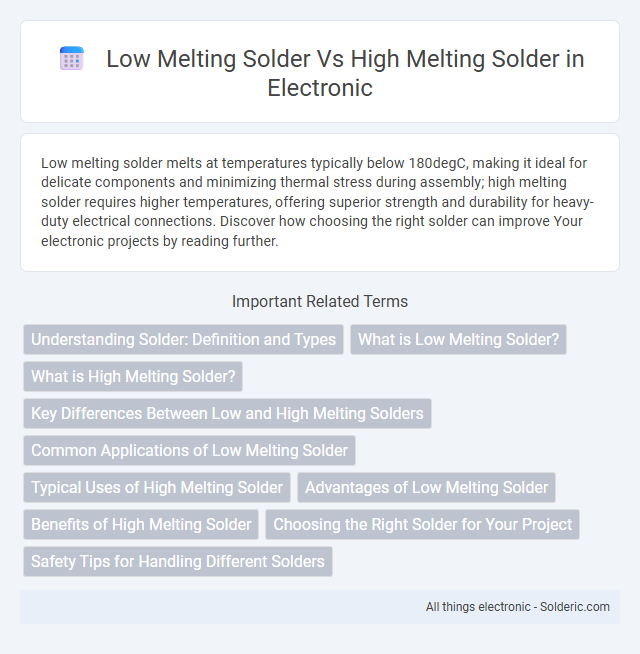Low melting solder melts at temperatures typically below 180degC, making it ideal for delicate components and minimizing thermal stress during assembly; high melting solder requires higher temperatures, offering superior strength and durability for heavy-duty electrical connections. Discover how choosing the right solder can improve Your electronic projects by reading further.
Comparison Table
| Feature | Low Melting Solder | High Melting Solder |
|---|---|---|
| Melting Point | Below 180degC (e.g., 60/40 Sn-Pb: ~183degC) | Above 180degC (e.g., SAC305: ~217-220degC) |
| Applications | Electronics assembly, delicate components | Heavy-duty joints, plumbing, automotive |
| Temperature Resistance | Lower temperature tolerance | Higher temperature tolerance |
| Mechanical Strength | Moderate strength | Higher mechanical strength and durability |
| Lead Content | Often contains lead (e.g., Sn-Pb) | Usually lead-free (e.g., Sn-Ag-Cu) |
| Appearance | Shiny, smooth finish | Duller finish, varies with alloy |
| Cost | Generally lower cost | Higher cost due to alloy composition |
Understanding Solder: Definition and Types
Low melting solder typically melts below 300degC, making it suitable for delicate electronic components due to minimal thermal stress. High melting solder, often composed of metals like silver and copper, melts above 300degC, providing stronger mechanical joints ideal for heavy-duty or high-temperature applications. Understanding the differences between these solder types helps you select the right material for effective and reliable electronic assembly.
What is Low Melting Solder?
Low melting solder is a type of solder alloy designed to melt at significantly lower temperatures, typically below 180degC, compared to high melting solder which melts above 180degC. This property makes low melting solder ideal for delicate electronic components and heat-sensitive assemblies, reducing the risk of thermal damage during the soldering process. Your choice of low melting solder ensures safer handling of sensitive materials while maintaining strong electrical and mechanical connections.
What is High Melting Solder?
High melting solder is an alloy that melts at temperatures typically above 300degC, often used for applications requiring strong mechanical joints and high thermal resistance. Common compositions include alloys based on silver, copper, and sometimes tin or zinc, offering enhanced durability in harsh environments. High melting solder is ideal for heavy-duty electrical connections and industrial machinery where standard low melting solders would fail under elevated temperatures.
Key Differences Between Low and High Melting Solders
Low melting solder typically melts below 180degC, offering faster bonding and reduced thermal stress on delicate components, whereas high melting solder requires temperatures above 180degC, providing stronger mechanical joints suitable for heavy-duty applications. Low melting solder is commonly used in electronics for fine components, while high melting solder suits plumbing and industrial uses due to its durability. Your choice between low and high melting solder depends on the application's temperature tolerance and mechanical strength requirements.
Common Applications of Low Melting Solder
Low melting solder is commonly used in delicate electronics assembly, jewelry making, and precision metalwork where minimal heat exposure prevents damage to components. Its lower melting point reduces thermal stress on sensitive materials, making it ideal for repairing circuit boards and assembling small mechanical parts. Your projects benefit from improved control and reduced risk of overheating when using low melting solder in these specialized applications.
Typical Uses of High Melting Solder
High melting solder, typically containing silver or copper, is commonly used in applications requiring strong, durable joints, such as plumbing, HVAC systems, and industrial metalwork. Its higher melting point allows it to withstand elevated temperatures, making it suitable for environments exposed to heat and mechanical stress. You should choose high melting solder when joint strength and thermal resistance are critical for the project's success.
Advantages of Low Melting Solder
Low melting solder offers the advantage of reducing thermal stress on electronic components during assembly, preventing damage to heat-sensitive parts. It enables faster soldering processes due to its lower working temperatures, improving production efficiency and energy savings. The use of low melting solder also facilitates easier rework and repair, minimizing the risk of PCB delamination and component degradation.
Benefits of High Melting Solder
High melting solder offers superior mechanical strength and thermal stability, making it ideal for applications exposed to high temperatures and mechanical stress. It enhances joint reliability in aerospace, automotive, and industrial electronics by maintaining integrity under extreme conditions. This solder type reduces risk of thermal fatigue and accidental remelting compared to low melting solder, ensuring longer-lasting, durable connections.
Choosing the Right Solder for Your Project
Low melting solder, typically composed of alloys like Sn-Bi or Sn-Pb, melts below 183degC, making it ideal for delicate electronic components and heat-sensitive materials. High melting solder, usually consisting of alloys such as Sn-Ag-Cu, melts above 217degC and provides stronger mechanical joints suited for robust applications and higher temperature environments. Selecting the right solder depends on the thermal tolerance of components, desired mechanical strength, and the specific requirements of your electronic or metalworking project.
Safety Tips for Handling Different Solders
Low melting solder typically contains lead or bismuth, requiring careful ventilation to avoid inhaling hazardous fumes during soldering. High melting solder, often made from alloys like silver or tin-copper, demands the use of heat-resistant gloves and eye protection to prevent burns from higher temperatures. Proper storage in labeled containers and following manufacturer safety data sheets ensure safe handling across all solder types.
Low melting solder vs high melting solder Infographic

 solderic.com
solderic.com